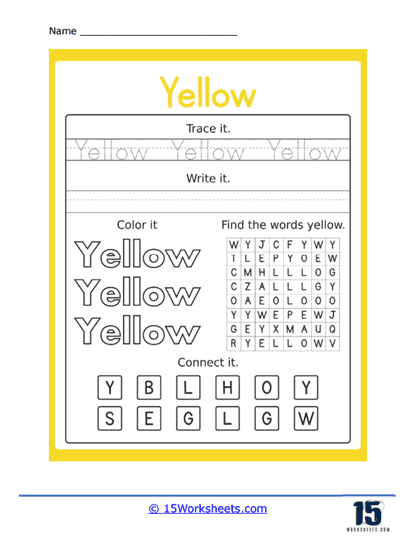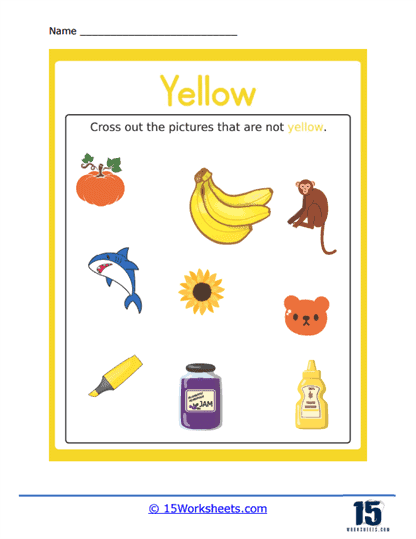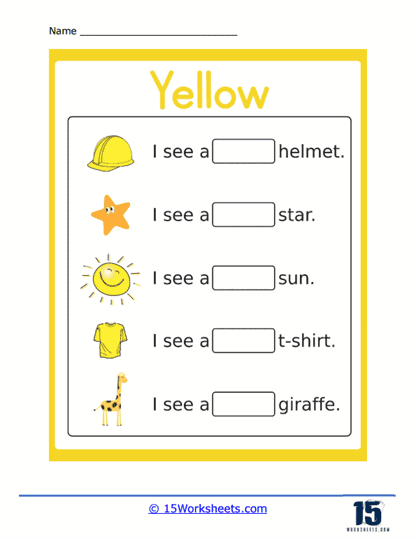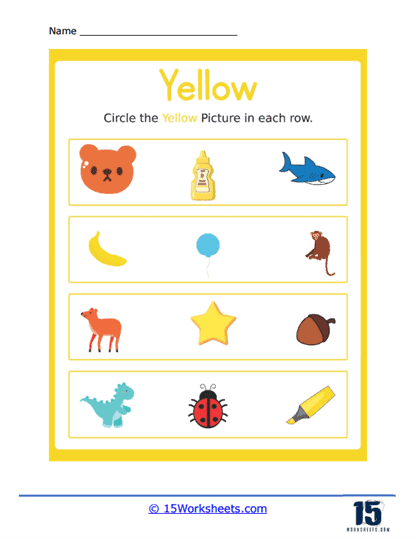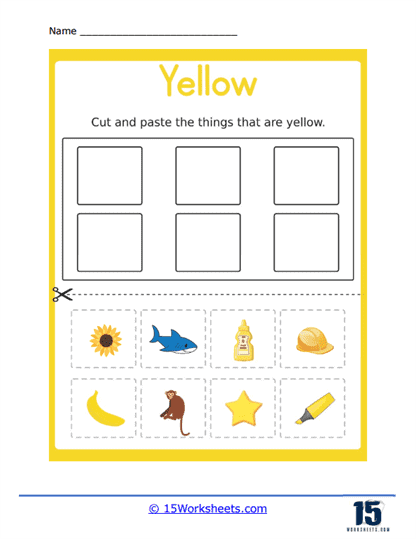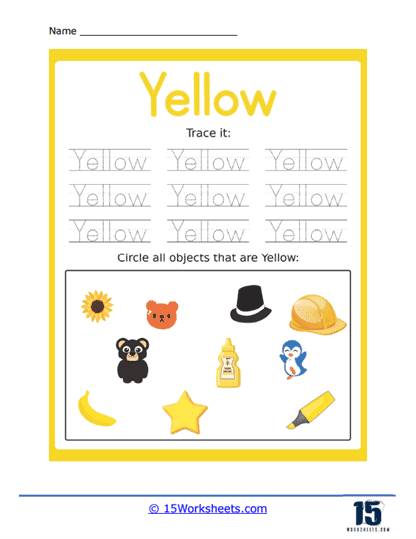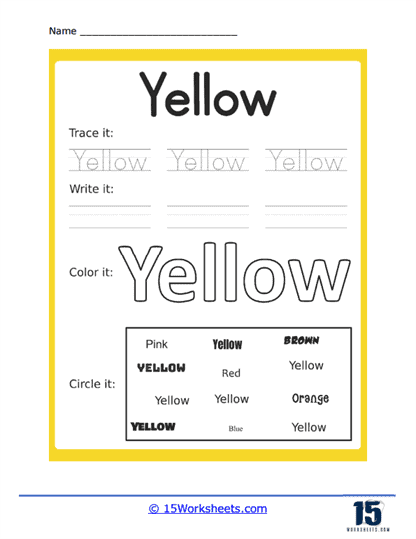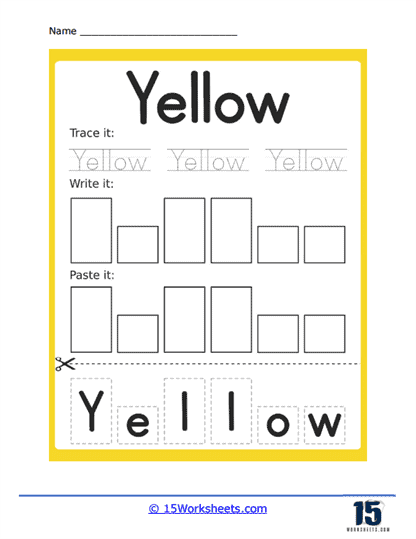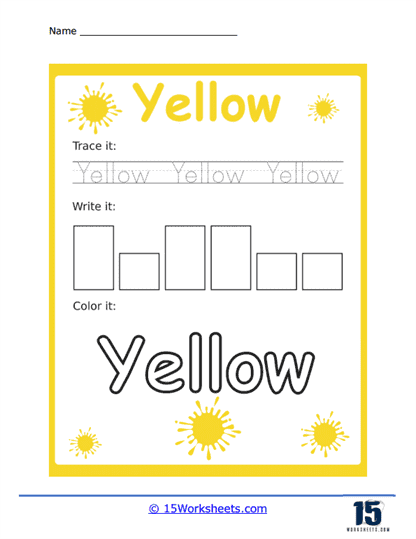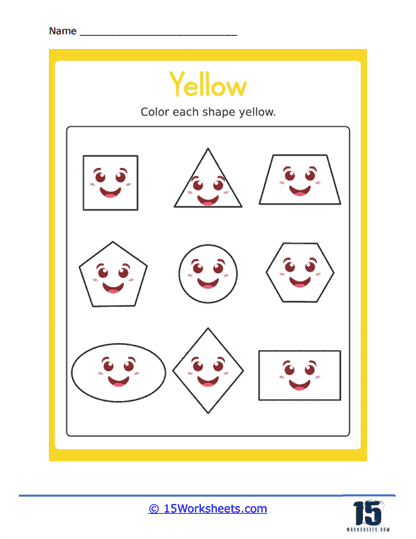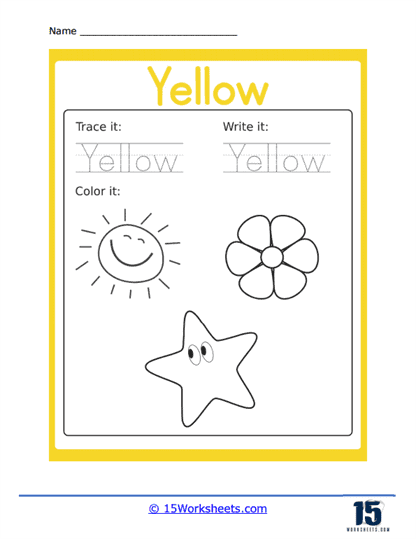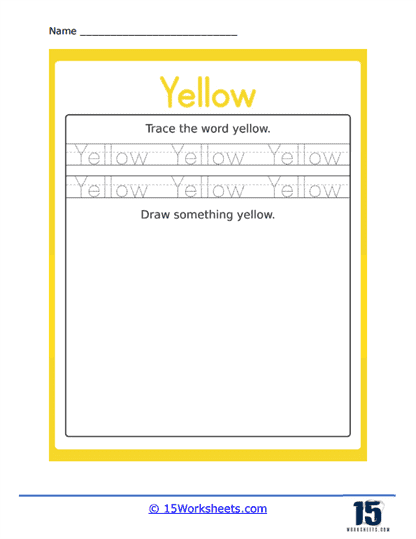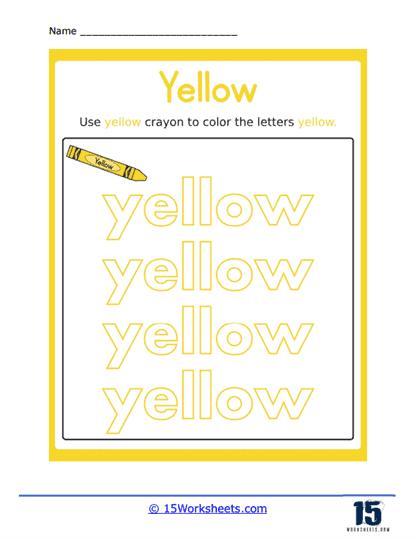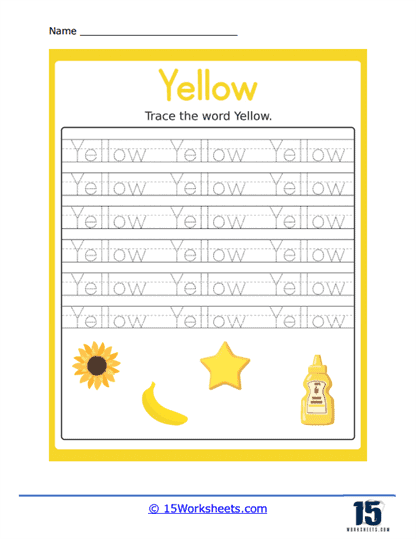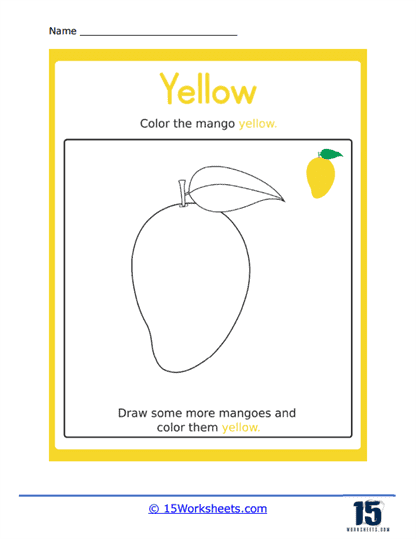Yellow Worksheets
All About These 15 Worksheets
Imagine a world awash with bright yellow-a color that exudes warmth, joy, and energy. The color yellow is more than just a visual experience; it’s a tool for learning, especially for young minds in their formative years. This is precisely what makes these Kindergarten worksheets centered around the color yellow such an invaluable resource. They are not just simple exercises but a gateway into the world of colors, creativity, and cognitive development. Through a thoughtfully designed series of worksheets, young learners are introduced to the vibrant world of yellow, paving the way for broader educational and developmental milestones.
The purpose of these worksheets is multifaceted, beginning with the introduction of yellow as a primary color. For young children, learning colors is a crucial early step in cognitive development. Yellow, with its bright and cheerful nature, naturally draws attention. By focusing on this color, children are given an opportunity to refine their visual recognition skills. Each worksheet contains interactive elements, such as identifying yellow objects, which may include familiar items like sunflowers, lemons, or school buses. These exercises help reinforce visual discrimination, a key skill in early childhood development that aids children in distinguishing between different visual stimuli.
The process of identifying and coloring yellow objects can have a profound impact on a child’s day-to-day life. For instance, understanding that bananas, the sun, and even certain road signs are yellow helps children make sense of the world around them. This not only strengthens their memory but also gives them a sense of familiarity with their environment. Imagine a child in a grocery store spotting a yellow pepper and confidently identifying its color-this simple act boosts their confidence and sense of accomplishment, encouraging further learning.
Beyond color recognition, these worksheets also help young learners build foundational literacy skills. The tracing exercises that focus on the word “yellow” are particularly beneficial. Tracing is a common early learning activity, but its importance goes beyond just writing practice. It enhances fine motor skills, hand-eye coordination, and muscle memory. By tracing the letters of the word “yellow” and eventually writing it independently, children are developing both their letter formation and early word recognition abilities. These skills are essential stepping stones toward more complex literacy goals, such as reading and writing complete sentences.
In addition to literacy and color recognition, these worksheets offer an opportunity for children to expand their vocabulary. Yellow is often associated with certain objects, emotions, and concepts. Through these activities, children will be exposed to items that are commonly linked with yellow, such as sunshine, rubber ducks, and smiley faces. Each new association builds their vocabulary, adding new words and ideas to their growing mental library. This expanded vocabulary will not only aid them in school but also enrich their everyday conversations and interactions with the world.
The creative aspects of the worksheets should not be overlooked. As children color yellow objects or draw their own yellow-themed creations, they are engaging in creative expression. Creativity is an essential life skill that goes beyond the arts-it fosters problem-solving abilities, critical thinking, and the capacity to see the world in new and innovative ways. Whether it’s coloring a yellow flower or drawing a radiant yellow sun, children are exercising their imaginations, which will benefit them in countless aspects of their personal and academic lives.
For example, a simple activity like drawing a yellow sun in the sky could spark questions about nature and the environment, leading to broader discussions about science. Or coloring a yellow school bus might prompt curiosity about transportation and the world of vehicles. These exercises plant seeds of curiosity and inquiry, encouraging children to explore new concepts and ideas beyond the immediate task at hand.
The hands-on nature of these worksheets promotes critical thinking and cognitive development. Completing these activities requires students to make decisions, solve problems, and follow instructions-all crucial components of cognitive growth. For example, a worksheet may ask students to circle the yellow objects among a variety of items in different colors. In making these choices, students are honing their ability to discriminate between different visual cues and applying their knowledge of color to a practical task.
The benefits of this series of yellow-themed worksheets extend beyond the classroom. The skills learned through these activities, such as fine motor coordination, color recognition, and vocabulary development, are directly applicable to everyday life. Think about a child tying their shoes or picking out an outfit for the day. Their ability to identify colors quickly and accurately is crucial in these situations. Even more, the fine motor skills honed through tracing letters will eventually help them with tasks like buttoning a shirt or using scissors.
One of the most significant advantages of these worksheets is how they foster a love for learning and art. Through engaging with color in a structured yet playful way, children begin to see art as a form of self-expression. This appreciation for creativity and the arts is something they will carry with them throughout their lives. The exploration of yellow, in particular, may lead them to notice the beauty of colors in their surroundings-from the golden hues of autumn leaves to the vibrant yellow of a sunset. These experiences shape not only their creative expression but also their appreciation for the natural world.
All About the Color Yellow
Yellow, a color that radiates warmth and vibrancy, sits comfortably between green and orange on the visible light spectrum. Its striking brightness and energy make it one of the most noticeable colors in nature and the world around us. Yellow often evokes feelings of happiness, optimism, and vitality, and it has been a symbol of various powerful concepts throughout human history. The color yellow is not just visually impactful but also rich in meaning, culture, and symbolism, spanning centuries and continents.
The Symbolism in Different Cultures
In many cultures, yellow is more than just a color—it carries profound symbolic significance. For example, in Buddhism, yellow is associated with learning, wisdom, and humility. Monks wear saffron robes, a shade of yellow, to signify their renunciation of material goods and their pursuit of enlightenment. Yellow, in this context, symbolizes a higher spiritual path, representing light, knowledge, and a peaceful existence.
In contrast, Chinese culture elevates yellow as a color of royalty, power, and prosperity. Historically, only the emperor was allowed to wear yellow, particularly during the Tang and Ming dynasties. The imperial yellow was seen as a reflection of the emperor’s divine right to rule and was intricately linked to the Earth itself, as the Chinese believed the center of the world was associated with the color yellow. This regal association has persisted over time, making yellow a color of good fortune, happiness, and abundance in Chinese festivals and traditions.
On the other hand, in Western cultures, yellow has varied interpretations. In many contexts, yellow signifies cheerfulness and positivity. However, there are also instances where yellow represents caution or even cowardice, as seen in the phrase “yellow-bellied,” which implies fear or timidity. The duality of yellow’s meanings across different societies highlights the color’s complexity and versatility.
The History of Yellow Pigments in Art
Yellow’s historical journey as a pigment is equally fascinating. Artists have been using yellow pigments for millennia, drawing from both natural and synthetic sources. One of the oldest known pigments is yellow ochre, which has been used since prehistoric times. Cave paintings in Lascaux, France, dating back over 17,000 years, feature yellow ochre, highlighting its early prominence in human expression.
As art evolved, so did the sources of yellow pigment. In the Renaissance, artists sought vibrant and long-lasting colors. This led to the introduction of lead-tin yellow, a bright and opaque pigment favored by European painters like Vermeer. However, as lead toxicity became a concern, other alternatives were sought.
The advent of modern chemistry in the 19th century brought synthetic pigments like cadmium yellow, which revolutionized the art world. Cadmium yellow, prized for its intensity and durability, became a favorite of Impressionists like Van Gogh and Monet, who used it to depict vivid landscapes and radiant light. The discovery of these synthetic pigments allowed for a broader range of yellow hues, from soft pastels to deep, golden tones, enriching the artistic palette and allowing artists to convey different moods and atmospheres.
In Nature: A Burst of Life
Nature is filled with the color yellow, offering a kaleidoscope of brilliant yellows in flora and fauna. Daffodils, sunflowers, and marigolds are just a few of the many flowers that bloom in yellow, often symbolizing new beginnings, warmth, and hope. The bright yellow petals of these flowers attract pollinators like bees, whose connection to yellow speaks to the color’s role in sustaining life.
Fruits like lemons, bananas, and pineapples are also renowned for their yellow color, signifying ripeness, freshness, and vitality. Lemons, with their sharp acidity, are often associated with energy and zest, reflecting yellow’s dynamic nature. Bananas, with their rich nutritional content, provide a softer, sweeter representation of yellow, highlighting the color’s ability to communicate a range of sensory experiences.
Animals, too, have embraced yellow for both functional and aesthetic purposes. Birds like goldfinches sport bright yellow plumage, often as a form of attracting mates, while certain insects, like yellow butterflies, use the color to blend into their environments or as a form of warning to predators. The presence of yellow in the animal kingdom showcases the color’s role in survival, communication, and beauty.
Fashion and Design
In fashion, yellow has always been a statement color, symbolizing energy, youth, and optimism. From the soft pastels of spring collections to the bold neon yellows seen on high-fashion runways, this color has the power to turn heads and convey a sense of confidence. While yellow can be a challenging color to wear, it is often used in accents or accessories to add a touch of brightness and positivity to an outfit.
In interior design and architecture, yellow has long been used to create warm, inviting spaces. Yellow walls or accents can make rooms feel larger and more cheerful, evoking sunlight and openness. Designers often recommend yellow for kitchens or dining areas because it stimulates appetite and conversation, enhancing the social dynamics of a home. It’s also used in children’s rooms and classrooms, where its association with energy and creativity can inspire playful learning environments.
Science and Technology
Yellow’s scientific relevance is equally important. In the world of optics, yellow light, with its specific wavelength, plays a crucial role in various technologies. For instance, sodium-vapor lamps, which emit a characteristic yellow glow, have been used in street lighting for decades because of their efficiency and visibility in foggy conditions. Similarly, in traffic signals, yellow is used as a transitional color, warning drivers to prepare for a change, embodying its role as a color of caution and attentiveness.
In industry, yellow dyes and pigments are crucial for manufacturing products from plastics to textiles. The need for bright, durable yellows led to innovations in pigment chemistry, ensuring that everything from packaging to fashion retains its vibrancy over time. The significance of yellow in materials science highlights its practical utility, extending beyond aesthetics to functional applications in daily life.
Idioms and Expressions
Yellow’s influence extends to language, where it often symbolizes particular emotions or traits. Expressions like “yellow-bellied” evoke the negative connotations of cowardice, while the phrase “mellow yellow” suggests a laid-back, easy-going attitude. “Yellow journalism,” a term coined in the late 19th century, refers to sensationalist reporting, where the news is exaggerated to attract attention-once again highlighting yellow’s connection to visibility and urgency.
Even in contemporary digital spaces, yellow is used to capture attention, whether in marketing, branding, or user interface design. Its ability to stand out and convey urgency or positivity makes it a versatile tool in communication strategies.
The Enduring Legacy of Yellow
Yellow’s enduring presence in art, nature, culture, and technology underscores its importance as a color that continues to shape human experience. Its many shades-from the pale, muted tones of pastel yellows to the deep, golden hues of autumn-offer a range of emotional and symbolic possibilities. Whether evoking the warmth of a summer sun, the richness of royal power, or the caution of a traffic light, yellow remains a color of contrast and complexity.
In every corner of life, yellow plays a role. It speaks to joy and creativity, while also embodying wisdom, caution, and power. As we continue to innovate and create, yellow will undoubtedly remain a central part of our visual and cultural landscape, continuing to inspire and influence in ways both subtle and bold.

